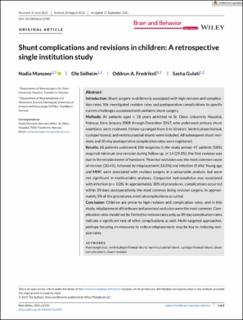| dc.description.abstract | Introduction Shunt surgery in children is associated with high revision and complication rates. We investigated revision rates and postoperative complications to specify current challenges associated with pediatric shunt surgery. Methods All patients aged < 18 years admitted to St. Olavs University Hospital, Norway, from January 2008 through December 2017, who underwent primary shunt insertions, were reviewed. Follow-up ranged from 1 to 10 years. Ventriculoperitoneal, cystoperitoneal, and ventriculoatrial shunts were included. All subsequent shunt revisions and 30-day postoperative complication rates were registered. Results 81 patients underwent 206 surgeries in the study period. 47 patients (58%) required minimum one revision during follow-up. In 14 (29.8%), the first revision was due to the misplacement of hardware. Proximal occlusion was the most common cause of revision (30.4%), followed by misplacement (18.5%) and infection (9.6%). Young age and MMC were associated with revision surgery in a univariable analysis, but were not significant in multivariable analyses. Congenital hydrocephalus was associated with infection (p = .028). In approximately 30% of procedures, complications occurred within 30 days postoperatively, the most common being revision surgery. In approximately 5% of the procedures, medical complications occurred. Conclusion Children are prone to high revision and complication rates, and in this study, misplacement of hardware and proximal occlusion were the most common. Complication rates should not be limited to revision rates only, as 30-day complication rates indicate a significant rate of other complications as well. Multi-targeted approaches, perhaps focusing on measures to reduce misplacement, may be key to reducing revision rates. | en_US |

